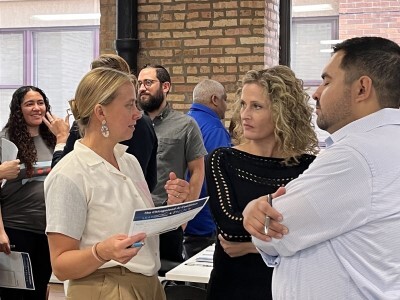Technology Tools
5 Technologies Impacting the Future of Learning Assessment
Topics

Educators often take advantage of educational technologies as they make the shifts in instruction, teacher roles, and learning experiences that next gen learning requires. Technology should not lead the design of learning, but when educators use it to personalize and enrich learning, it has the potential to accelerate mastery of critical content and skills by all students.
Feedback is incredibly important in student learning and motivation. Here are five current and emerging technologies that are enabling more frequent, low-stakes feedback—making an impact on the future of learning assessment.
When I first made the move into higher education, I spent five years leading a center to help faculty improve learning outcomes in their classrooms.
It was common for new faculty members to come to me after the first year of teaching, disappointed at student performance as well as the results of course evaluations. The fun part of working with such faculty is that it was usually pretty easy to help them take their teaching to the next level. In almost every situation, the fastest way to improve student learning and student satisfaction in a course was to help the professor conduct what I now call an extreme classroom assessment makeover.
Many faculty members went into higher education teaching with the mindset that assessment is something you do through a mid-term, a final exam and maybe two or three other papers or projects. Yet, we have ample research over the last 40 years to tell us that feedback is incredibly important in student learning and motivation. When students get frequent, low-stakes feedback, it gives them a better sense of their strengths and challenges. How do you improve at something if you don’t have a means of finding out whether you are making good progress? As such, simply helping faculty create ways for students to receive feedback along the way was a quick approach to decreasing student anxiety, improving student motivation, supporting student ownership, and quite often, increasing student learning.
EdTech Supports Feedback & Productivity
Educational technology was often our friend. I could help faculty discover the power of creating simple practice quizzes in the learning management system. I introduced them to one of the many polling software solutions that allow both student and instructor to get instant feedback. I also helped them think about how they could use simple communication and productivity technologies such as Google Docs, online threaded discussions, various synchronous collaboration tools, and others to design opportunities for students to give one another helpful peer feedback. These simple practices consistently provided great outcomes.
The exciting part to me is that we are still in the early stages of these tools and technologies. Their capacity to assist with designing both simple and complex formative feedback loops for students will greatly expand over the coming years. Meanwhile, assessment technologies continue to gain traction in higher education. As such, I encourage us all to keep our eyes out for current and emerging educational technologies that will help students (and faculty) receive much-needed, formative and low-stakes feedback. Here are five current and emerging possibilities that are making an impact on learning assessment:
1. Polling and Quizzing Software
We are now past our third or fourth decade of readily available polling and quizzing technologies. Starting with the growth of clickers in higher education, there are now hundreds of software and mobile device solutions at the disposal of faculty today and their features are expansive. We have tools that allow for real-time polling, as well as polling and quizzing embedded into self-paced student learning experiences and readings. Content publishers and university teams are taking what used to be static course content and are embedding polling and quizzing features in ways that both track and check student understanding. This might seem like an old technology to many people today, but we’ve only seem the beginning of what these tools have to offer in a real-time classroom setting.
2. Adaptive Learning
In fact, polling and quizzing software is a set of features that make up a much larger and more emergent set of adaptive learning technologies. Imagine this: a student goes through a self-paced learning experience that includes text, multimedia, case studies, and more. As this happens, the student’s understanding is assessed and the learning experience constantly adjusts to optimize his or her progress throughout the module. Look for many promising developments in this area from organizations like Carnegie Learning, Knewton, Acrobatiq, leading publishers, and a growing number of others investing in helping create the future of adaptive learning.
3. Algorithmic Feedback Tools
Do you remember some of those early essay checker tools? You could cut and past your essay and it would give you a score or a few suggestions on how to improve it. Even before these technologies emerged, writing changed as spellchecker (then known as grammar checkers) became a standard part of writing an essay in the digital age. These technologies are expanding and improving in fascinating ways. If you’re a blogger using a common tool like Wordpress, with the right plug-in, the software will give you feedback on search engine optimization (SEO) for your essay, as well as how to improve its readability. It will analyze your essay for passive voice, the complexity of sentences, transition words, word choice, and other elements deemed important in crafting quality essays. Tools like Grammarly, which started as a simple grammar check, are now built upon increasingly complex algorithms that offering more detailed feedback to writers. This is also just in its infancy, with far more robust feedback emerging every year. I’m not suggesting that these will replace human writing instruction this year or next, but they certainly give learners valuable formative feedback.
4. Student Behavior Feedback
Learning analytics tools are giving us the means of tracking a growing number of student behaviors. If you are in a blended learning or online course, I can track how often you log in, what pages you view, how much time you spend on a given page, how you interact with others as well as the instructor, and much more. Over time, we can identify trends and predictors of student success. Students who engage in certain behaviors or develop certain habits are more likely to thrive than students who don't. Learning Management Systems and other products are building these features into their systems, but most faculty and academic leaders in higher education are just beginning to think about how to use them in ways that provide valuable feedback to both instructors and students. This will be a common practice in five years, so now is the time to start experimenting and planning.
5. Communication Technologies
Some current college students were just starting Kindergarten when Skype first went into business. Since then, we’ve had a myriad of communication tools join us and become a standard part of social and academic life. Although none of these were initially built to be assessment tools, they play a very important part of present and future formative assessment in higher education. Here’s how: these technologies make it possible for any student to connect with and gain feedback on work from people around the world, including leading experts. Creative and conscientious students are already leveraging these tools to get feedback on their work and learning. Look for more universities and faculty to start making these more integrated and intentional forms of formative feedback in the near future.
There are countless other feedback and assessment technologies worth exploring, but these five are definitely worth having near the top of your list. They already have some traction, there is an impressive amount of research and development going into them, individual instructor and/or learner use of these is already increasing, and there are a growing number of more strategic university conversations about how to capitalize on these technologies. Most importantly to me, these are also educational technologies we can use to add much-needed formative feedback to the higher education learning experience.




